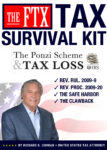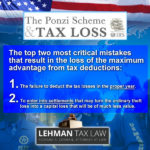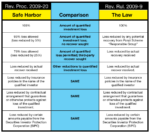REPORT 2 in the FTX, Sam Bankman-Fried, Alameda Research, Fraud

REPORT No. 2: FTX and Sam Bankman-Fried Fraud
By Richard S. Lehman, United States tax Attorney
Introduction
Report No. 1 introduced the reader to a key phrase. The phrase is a reasonable prospect of recovery. This phrase determines whether a deduction for the theft loss in a Ponzi scheme, such as FTX’s, should be taken in the year it is discovered or some other future year. The law does not permit the deduction to be claimed in a year prior to the year of discovery.
Since the timing of the theft loss deduction is critical to the real economics of the recovery, this phrase is all important.
Therefore, before considering tax planning opportunities, this Report will study the phrase a reasonable prospect of recovery in more depth.
The phrase finds its origin in the early internal revenue codes that permitted a theft loss deduction for losses sustained in a taxable year but did not define the word sustained. Therefore, prior to 1954 the law was unsettled as to when a loss was sustained. This caused taxpayers to often lose their tax deduction for a theft loss when the statute of limitations had run on prior years; and it was later found that a loss had been sustained in one of those prior years that was no longer open for change.
The new law in 1954, that still applies today, adopted the principle that generally a theft was sustained in the year of discovery. However, this definition was tempered since it only applies to that portion or all of the theft loss that the taxpayer could identify as not having any reasonable prospect of recovery. Until it was clear that a loss was assured and closed and completed, there would be no deduction. The law attempts to make sure there is no deduction in the year of discovery or any other year unless the loss is assured.
There is no set of fixed rules that clearly define the taxpayer’s reasonable prospect of a recovery, that will result in a limitation of a taxpayer’s theft loss deduction in the year of discovery. However, it is possible to have a grasp of the concept by reviewing court statements defining the concept. We will also look at general principles that have emerged from the court cases and review two cases that could be said to represent the extreme ends of the spectrum of just what is a reasonable prospect of recovery.
Note: As explained in Report No. 1, most taxpayers will want to claim their theft loss deduction(s) starting in 2022 for maximum tax benefits and to take advantage of the legal standard that governs the allowance of the theft loss deduction in the year of its discovery.
One court has defined the reasonable prospect of recovery as follows:
This court must determine what was a reasonable expectation as of the close of the taxable year for which the deduction is claimed. The situation is not to be viewed through the eyes of the incorrigible optimist and hence, claims for recovery whose potential for success are remote or nebulous will not demand a postponement of the deduction. The standard is to be applied by foresight, and hence, we do not look at facts whose existence or production for use in later proceedings was not reasonably foreseeable as of the close of the particular year. Nor does the fact of a future settlement or favorable judicial action on the claim control our determination if we find that as of the close of the particular year, no reasonable prospect of recovery existed.
. . . a determination of whether a loss was in fact sustained in a particular year cannot fairly be made by confining the tier of facts to an examination of the taxpayer’s beliefs and actions. Such an issue of necessity requires a practical approach, all pertinent facts and circumstances being open to inspection and consideration regardless of their objective or subjective nature.
In determining whether a reasonable prospect of recovery existed as of the year of discovery, we start from the premise that petitioner is not required to avoid both the scullion role of the incorrigible optimist and the charbdian character of the estygian pessimist. The standard to be applied is the EXERCISE OF SOUND BUSINESS JUDGMENT BASED UPON AS COMPLETE INFORMATION AS IS REASONABLY OBTAINABLE.
Another court has stated it as:
The reasonableness of a taxpayer’s prospect of recovery is primarily tested objectively, although a court may consider to a limited extent evidence of the taxpayer’s objective contemporaneous assessment of his own prospect of recovery. “[t]he taxpayer’s attitude and conduct are not to be ignored, but to codify them as the decisive factor in every case is to surround the clear language of . .. [the statute] with an atmosphere of unreality and to impose grave obstacles to efficient tax administration.”
In addition to these general statements, the courts in deciding whether there is a prospect for a reasonable recovery have also agreed on several principles that provide further guidance:
(i) In determining the reasonableness of a taxpayer’s belief of loss the courts had to be practical and aware of the individual facts of a case.
(ii) The relevant facts and circumstances are those that are known or reasonably could be known as of the end of the tax year for which the loss deduction is claimed. The only test is foresight, not hindsight.
(iii) Both objective and subjective factors must be examined.
(iv) The taxpayer’s legal rights as of the end of the year of discovery are all important and need to be studied to make a proper decision.
(v) One of the facts and circumstances deserving of consideration is the probability of success on the merits of any claim brought by the taxpayer.
(vi) The filing of a lawsuit may give rise to an inference of a reasonable prospect of recovery. However, the inference is not conclusive nor mandatory. The inquiry should be directed to the probability of recovery as opposed to the mere possibility. A remote possibility of recovery is not enough; there must be a reasonable prospect of recovery at the time the deduction was claimed, not later.
The bottom line of the timing of the theft loss deduction is this.
Under the law a taxpayer who has suffered a theft loss shall take a theft loss deduction in the year the loss is sustained, which is the taxable year in which the taxpayer discovers the loss. However, if in the year the taxpayer discovers the loss, there exists a reasonable prospect of recovering some portion of the loss or all of the loss; the taxpayer must postpone the theft loss deduction for that portion or all of the loss that may reasonably be recovered.
If a taxpayer does not take a theft loss deduction for the entire loss in the year of discovery because the taxpayer has a reasonable prospect of recovering all or a portion of the loss, the theft loss deduction will be postponed until there is a recovery or there is a certainty that the postponed recovery will not happen. The theft loss deduction will not be lost by virtue of it being postponed.
During taxable years after the year of discovery, the taxpayer may take a theft loss deduction for that portion of any postponed losses when the taxpayer can ascertain with reasonable certainty that the reimbursement will in fact no longer be received. A taxpayer may ascertain with reasonable certainty whether he or she will be reimbursed by a settlement of the claim, by an adjudication of the claim or by an abandonment of the claim.
Lawsuits
Another way to try to appreciate the concept of a reasonable prospect of recovery is to review a few of the cases that were hotly contested and could be said to be on the extreme ends of the view of whether or not a taxpayer had a reasonable prospect of recovery. In reviewing these cases it is important to keep in mind that the presence or absence of a lawsuit seeking recovery is often a big factor in determining whether the taxpayer believed they would receive a recovery or not.
One court in weighing whether the presence of a lawsuit seeking recovery should determine whether the taxpayer had a reasonable prospect for recovery put it this way.
While we offer no detailed opinion as to the merits of the taxpayer’s legal position . . . we find that the taxpayer did have a reasonable prospect of recovering something. In arriving at this conclusion, we stress that the mere existence of a POSSIBLE claim or pending litigation will not alone warrant postponing loss recognition. There are many reasons for initiating lawsuits. In this case, taxpayer’s antitrust claim for treble damages exceeded 19 million dollars. Where the stakes are so high, a suit may be 100% JUSTIFIED even though the probability of recovery is miniscule. In short, although we offer no litmus paper test of reasonable prospect of recovery, we note that the inquiry should be directed to the probability of recovery as opposed to the mere possibility. Analyzing the rule in percentage terms, we would consider a 40 to 50 percent or better chance of recovery as being REASONABLE. A lawsuit might well be justified by a 10 percent chance.
Normally where a taxpayer is in good faith willing to go to the trouble and expense of instituting suit to recoup a theft type loss, the courts seem to find that as a matter of fact there was a sufficient chance of at least part recovery to justify that the taxpayer should defer the claim of a theft loss deduction until the litigation in question is concluded. This is not to suggest that in some cases the facts and circumstances will not show such litigation to be specious, speculative, or wholly without merit and that the taxpayer hence was not reasonable in waiting to claim the loss as a deduction.
Another court stated the importance of a lawsuit in determining a reasonable prospect of recovery as follows
. . . the mere existence of pending litigation won’t alone warrant postponing loss recognition. In determining whether there’s a reasonable prospect of recovery, the inquiry should be directed to the probability of recovery as opposed to the mere possibility. And where the taxpayer’s chances of recovery in a lawsuit were in the realm of remote possibility rather than reasonable prospect, the court held that postponement of the loss deduction wasn’t required.
Case Law
Looking at the two cases that also will help define the reasonable prospect of recovery standard, we see two situations in which great efforts were made to seek a recovery of a loss, including extensive litigation. In both cases the courts did a complete analysis of the legal rights of the taxpayers and determined in one line of cases the taxpayer did not have a reasonable prospect of recovery even though the taxpayers never wrote the theft loss off of their corporate financial statements in the year of discovery; had tremendous lobbying efforts on their behalf both individually and through trade groups to recoup their losses from multiple sources; and in the case of one taxpayer (a bank) even had the perpetrators’ money deposited in their bank while the actions seeking recovery were ongoing. Since the victim, a bank had no legal rights to hold the deposited money; the funds were released from the victim bank to the perpetrator of the theft.
This was the situation when the Iranian government expropriated assets of U.S. companies in Iran with the fall of the Shah of Iran and the Iranian Hostage taking. In this case, the I.R.S. argued against permitting a theft loss in the year of discovery.
In spite of several potential areas of recovery, which did in fact later lead to recovery and consideration that was paid for confiscated assets; the court was convinced that no legal rights existed for recovery in the year of discovery. Without legal rights, efforts that may present only a possibility of recovery are not enough to stop the taxpayer from taking the theft loss deduction in the year of discovery.
On the other hand, while in the Iranian expropriation cases the existence of only possible legal rights did not foreclose the deduction, another court took a different view of the presence or absence of legal rights in the year of discovery. In this other court the I.R.S. insisted that a taxpayer must take his theft loss in the year of discovery because of the status of that taxpayer’s legal rights.
There, even though a taxpayer won litigation in the lower court awarding him a recovery, the Court found the lower court’s ruling was illogical and that in spite of the ruling allowing a recovery, the taxpayer had no real possibility of a recovery. The Court ruled that this taxpayer had no legal rights to recovery and was therefore forced to take the deduction in the year of discovery. The Court’s independent review of the litigation awarding the recovery was that the lower court’s opinion (which was in fact overruled) was wrong. Therefore, the taxpayer could not even rely on a successful lower court opinion to support his belief in the year of discovery that there would be a recovery.
Now you see why we have tax lawyers.
Tax Planning
The term tax planning usually envisions taking steps in advance of an economic transaction in order to maximize tax benefits from the profits that may occur from the transaction. There is also the concept of the post mortem tax planning which is found in the estate tax area and provides some flexibility for transactions and the setting of tax values after death.
Tax planning for the maximum tax benefits from the FTX loss will have a little bit of both. The loss has already occurred, however, what remains is how the taxpayer will plan and implement his or her FTX tax loss for maximum benefits now and in the future.
The tax planning for the most part will be to provide the taxpayer with appropriate projections of the use of the tax losses under differing circumstances so that the client will be able to understand the financial effect of various options that the tax loss and litigation recoveries may provide for.
A litigation counsel as part of the team is critical to a successful professional product for several reasons. Each victim should understand every possible means of recovery that might be applied to the individual. Recoveries from SIPC and the IRS are not the only avenues of recovery that will be considered. As the facts unfold there may be more culprits of economic substance that can be a target of recovery.
Certain accountants, financial advisors, principals of feeder funds, boards of directors and the various bankrupt estates may be just a few of the potential sources of recovery. If these sources of recovery are viable, and will need to carefully weigh the pluses and minuses of the postponed tax benefits that may result from a victim choosing to actively pursue certain areas of recovery. As in all economic matters, the emphasis should always be on the maximum recovery of money from third parties before relying on the recovery from tax benefits.
This author believes that the tax planning should result in a professional work product that will most likely accompany an amended return or similar type of I.R.S. filing. The document will most likely be the work product of at least three of the client’s advisors. This should consist of their accountant or an accountant specialized in this area; a tax attorney and litigation counsel.
The litigation lawyer will not only be necessary to analyze avenues of recovery and litigation claims, the litigator will also be important as an expert who is well versed regarding the viability or non viability of any claims for recovery. Therefore he or she will be very helpful in the taxpayer determining those avenues to pursue and those avenues that should be discontinued if their continuation would provide the I.R.S. with a strong argument to not permit the theft loss in the year of discovery, 2022.
The third essential expert is the tax lawyer who will need to coordinate all of the matters in light of the taxpayer’s objectives and various legal standards that will need to be met to achieve those objectives.
With the professional team in place, the steps generally will be as follows:
- Records.
The taxpayer must gather as complete a collection as possible of all financial records for as far back as one can find that involved the Sam Bankman-Fried investment. This should include statements, tax returns and in some cases even estate tax returns. - Basis Calculations.
A determination of the taxpayer’s tax basis in the Sam Bankman-Fried loss must be undertaken. This basis needs to be calculated for each separate account as there may be different tax treatments and basis for estates, trusts, individuals, both American and non residents, corporations both domestic and foreign and charities. - Sources of Recovery.
A detailed description should be made of the various sources of recovery that have been explored. In those areas where no recovery is possible or none sought, a taxpayer may want to formally renounce rights to certain forms of recovery to ensure that there is no question that the taxpayer had no reasonable belief of a prospect of recovery as to those rights. - Loss in Year of Discovery.
Once the sources of recovery have been inventoried a determination should be made regarding the maximum potential loss that can be deducted for the year 2022. It will be critical to prove that if a taxpayer is seeking a source of recovery that the recovery is not reflected as the possibility to recover an unlimited or maximum amount of recovery if that is not truly the case. Recoveries that are open ended in nature will harm the chances to claim the theft loss deduction in 2022. - Accounting Schedules and Forecasts.
Upon determining the amount of theft loss for which there is no potential for recovery in
2022, it is then important to prepare the appropriate accounting schedules. These should reflect the effect of the tax losses and the cash that may be recovered from amended returns and the tax free income that may be earned because theft losses may be carried forward for 20 years.
These projections will be critical. For example, there may be a fairly recent estate involved in which an estate tax has been paid on the FTX funds that were inherited. If this is the case, this must be considered in the calculations as the estate tax deduction, if available, may have a value of 45% to the taxpayer versus the 35% benefit of the income tax deduction.
Furthermore, these projections should be useful for planning purposes. Calculations will be needed to keep track of the theft tax losses that will be deferred in those cases where the taxpayer believed there was a reasonable prospect of recovery. In those cases, in the event eventually there is a recovery, the recovery will not be subject to tax but will reduce any original unused theft tax losses. To the extent a recovery exceeds any theft tax loss, it will be subject to taxation.
Once these basic steps have been taken, so that the taxpayer is aware of all of the options, there will be a number of considerations; some of them that may need to be acted on quickly.
IN THE EVENT AN ESTATE TAX DEDUCTION MAY BE MORE VALUABLE THAN THE INCOME TAX DEDUCTION, IT WILL BE VERY IMPORTANT TO PAY ATTENTION TO THE STATUTE OF LIMITATIONS ON THE FILING OF THE FORM 706 ESTATE TAX RETURN.
There are many real life examples that will start the reader thinking about the maximum tax planning for the FTX losses.
Assume an elderly victim of the FTX theft may have significant unused theft tax losses that can only be used as a carry forward over the next 20 years. This income tax benefit might be cut short with the death of the FTX victim. Is it possible to plan the family situation to preserve these losses or use them up on other income during the FTX victim’s life?
One might ask in a town like Palm Beach, how many tax marriages or tax mergers might result. For example, unmarried Mr. X may be broke with a $20 Million theft tax loss that he cannot use going forward since he has little or no income. On the other hand, the widowed Mrs. Y may have an income stream of $4 Million a year and really hates to pay taxes. Does a joint income tax return that permits X’s net operating losses to be used by a future Mrs. X make this a wedding made in heaven?
Value can be lost without good professional advice.






